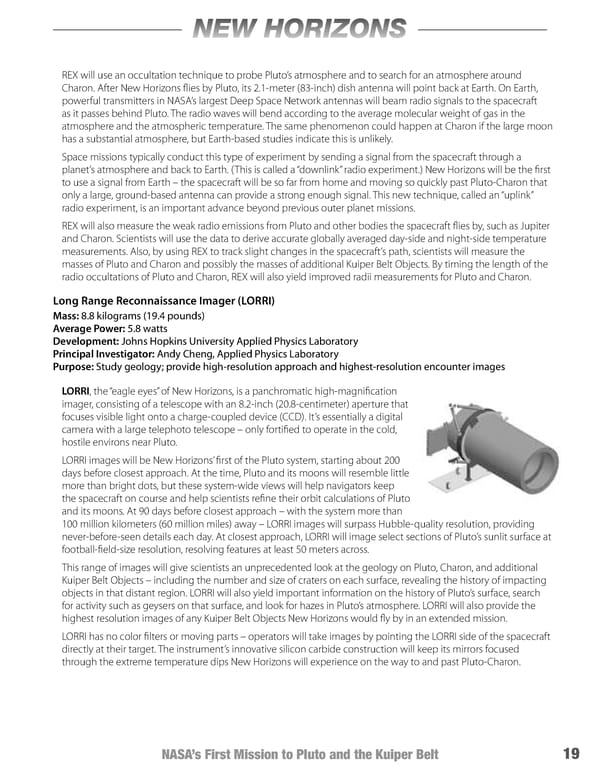NEW HORIZONS REX will use an occultation technique to probe Pluto’s atmosphere and to search for an atmosphere around Charon. After New Horizons flies by Pluto, its 2.1-meter (83-inch) dish antenna will point back at Earth. On Earth, powerful transmitters in NASA’s largest Deep Space Network antennas will beam radio signals to the spacecraft as it passes behind Pluto. The radio waves will bend according to the average molecular weight of gas in the atmosphere and the atmospheric temperature. The same phenomenon could happen at Charon if the large moon has a substantial atmosphere, but Earth-based studies indicate this is unlikely. Space missions typically conduct this type of experiment by sending a signal from the spacecraft through a planet’s atmosphere and back to Earth. (This is called a “downlink” radio experiment.) New Horizons will be the first to use a signal from Earth – the spacecraft will be so far from home and moving so quickly past Pluto-Charon that only a large, ground-based antenna can provide a strong enough signal. This new technique, called an “uplink” radio experiment, is an important advance beyond previous outer planet missions. REX will also measure the weak radio emissions from Pluto and other bodies the spacecraft flies by, such as Jupiter and Charon. Scientists will use the data to derive accurate globally averaged day-side and night-side temperature measurements. Also, by using REX to track slight changes in the spacecraft’s path, scientists will measure the masses of Pluto and Charon and possibly the masses of additional Kuiper Belt Objects. By timing the length of the radio occultations of Pluto and Charon, REX will also yield improved radii measurements for Pluto and Charon. Long Range Reconnaissance Imager (LORRI) Mass: 8.8 kilograms (19.4 pounds) Average Power: 5.8 watts Development: Johns Hopkins University Applied Physics Laboratory Principal Investigator: Andy Cheng, Applied Physics Laboratory Purpose: Study geology; provide high-resolution approach and highest-resolution encounter images LORRI, the “eagle eyes” of New Horizons, is a panchromatic high-magnification imager, consisting of a telescope with an 8.2-inch (20.8-centimeter) aperture that focuses visible light onto a charge-coupled device (CCD). It’s essentially a digital camera with a large telephoto telescope – only fortified to operate in the cold, hostile environs near Pluto. LORRI images will be New Horizons’ first of the Pluto system, starting about 200 days before closest approach. At the time, Pluto and its moons will resemble little more than bright dots, but these system-wide views will help navigators keep the spacecraft on course and help scientists refine their orbit calculations of Pluto and its moons. At 90 days before closest approach – with the system more than 100 million kilometers (60 million miles) away – LORRI images will surpass Hubble-quality resolution, providing never-before-seen details each day. At closest approach, LORRI will image select sections of Pluto’s sunlit surface at football-field-size resolution, resolving features at least 50 meters across. This range of images will give scientists an unprecedented look at the geology on Pluto, Charon, and additional Kuiper Belt Objects – including the number and size of craters on each surface, revealing the history of impacting objects in that distant region. LORRI will also yield important information on the history of Pluto’s surface, search for activity such as geysers on that surface, and look for hazes in Pluto’s atmosphere. LORRI will also provide the highest resolution images of any Kuiper Belt Objects New Horizons would fly by in an extended mission. LORRI has no color filters or moving parts – operators will take images by pointing the LORRI side of the spacecraft directly at their target. The instrument’s innovative silicon carbide construction will keep its mirrors focused through the extreme temperature dips New Horizons will experience on the way to and past Pluto-Charon. NASA’s First Mission to Pluto and the Kuiper Belt 19
 New Horizons Page 27 Page 29
New Horizons Page 27 Page 29